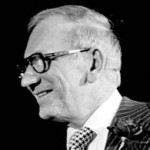They don’t make big city mayors like they used to. Great mayors in my time came to represent the spirit of a city. The mayor was a promoter. His first job was to sell the city to the people who lived there, then sell it to the rest of the world.
Cities first became important in Canadian life in the 1950s. You did not say you were an Albertan, you said you were a Calgarian. You didn’t say you were a Manitoban, you were a Winnipegger.
There was no more flamboyant big city promoter than Stephen Juba, nine-term mayor of Winnipeg. He was a remarkable man, perhaps the greatest mayor Canada ever had. Winnipeg was then the fourth-largest city in the country but a very dull and tedious place. Juba transformed it single-handedly.
He was a North End Ukrainian-Canadian, an immigrant carpenter’s son who left school at 15. He worked in a box factory and wound up as an appliance dealer. Winnipeg was culturally segregated then, and people like Juba were the hoi polloi. Mayors always came from River Heights, a south end Anglo-Saxon Protestant enclave. Juba did not fit this mold. One newspaper said he “looks like a card shark and talks like a bookie.”
Juba lost his first five elections. He finally won a term in the legislature in 1953, and was elected mayor three years after that. City Hall was a light-hearted place in those days and reporters did not take themselves as seriously as they do today. I recall a legendary alderman, Slaw Rebchuk, a wonderful man famed as a phrase-maker. He’d say, “A verbal agreement isn’t worth the paper it’s written on”; “I want to see this put down in black and writing”; “You buttered your bread – now lie in it.” Rebchuk served 28 years on council. They named a Salter Street overpass in his honour.
Reporters liked Juba. He was brash and colourful. He liked to attend fires wearing a firefighters’ helmet, and he liked Cadillacs. Juba promised as mayor he would buy his own, and after winning election in 1956 invited reporters to the steps of City Hall to see his new Cadillac. It was amethyst and alpine white with huge fins, like an aeroplane preparing for take-off. This was in all the papers the next morning: If you see a Cadillac, amethyst and alpine white, that belongs to your mayor.
Juba stayed 21 years as mayor. He personified the spirit of the era. He gave Winnipeg the Pan-Am Games – this was forty years before Toronto thought of bidding – and dreamed of municipal monorails and a weatherproof dome for downtown Winnipeg. He personified the buoyant optimism of the 1950s and early ‘60s. We beat the Depression, we won the war, and now we were going to build the peace. This sense of accomplishment gripped the whole country.
They gave Juba the Order of Canada in 1971, “for his services over many years as mayor of Winnipeg.” Near the end of his life he calculated he’d owned no fewer than 25 Cadillacs.
(Editor’s note: the author was a former publisher, educator and National Newspaper Award-winning reporter with the Winnipeg Free Press. Mr. Byfield died in 2021. His commentary was originally published May 1, 2016)






